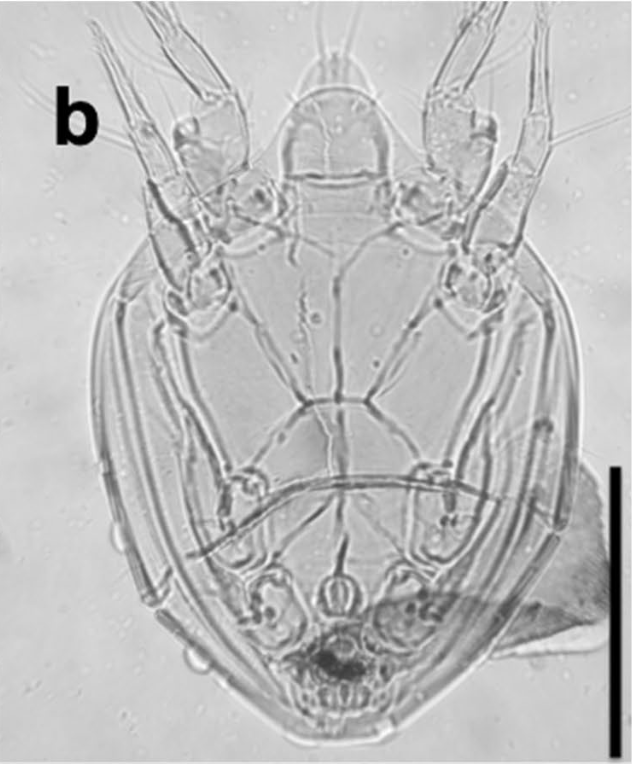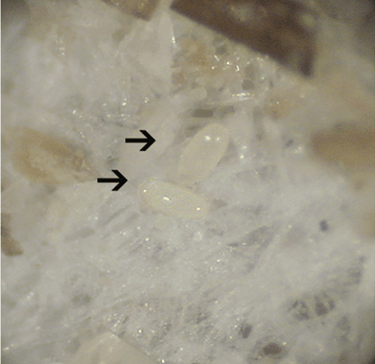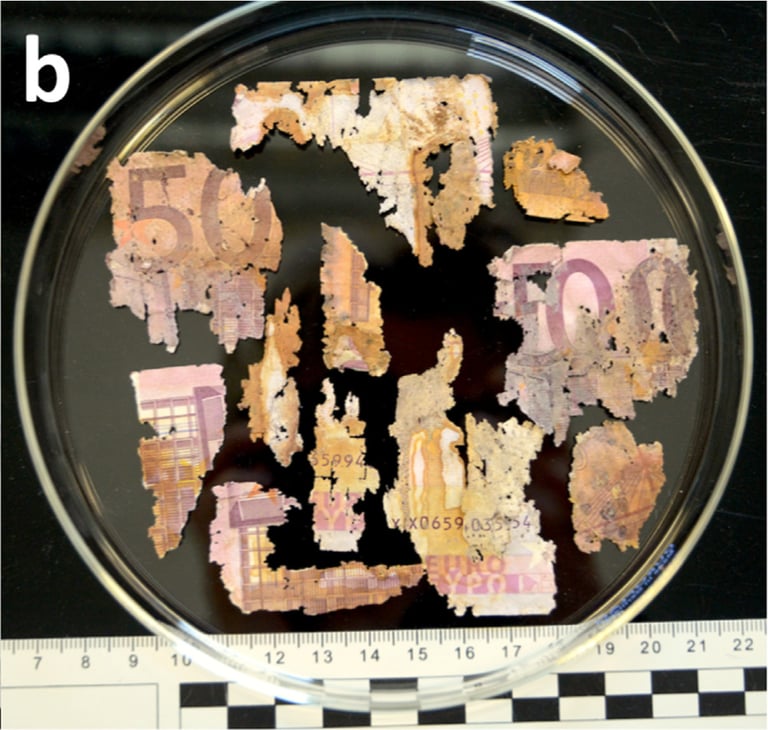Forensic Acarology
Hani M, Thieven U, & Perotti MA. 2018
Soil bulb mites as trace evidence for the location of buried money.
Forensic Science International 292, e25-e30.
This study reports for the first time the use of soil micro-invertebrates, mites, as trace evidence to localise buried objects such as money.
The case relates to a crime in Germany, where a large sum of banknotes had been hidden in an unknown location, likely abroad. In 2016, part of the money (approx. €500,000 in €500 value notes) was confiscated by the police. After analysis in the forensic lab, it was discovered that the notes were covered with small particles of a sort of debris, later identified as specimens of Rhizoglyphus howensis Manson, a non-European, nor Mediterranean species of root or bulb mites (Acaridae: Rhizoglyphinae).
The restricted biogeographic distribution of R. howensis, originated in unspoiled forest soil in the Australasian region, limited the search for the money to the areas visited by the perpetrators during their trips to the region.
Rhizoglyphus howensis biology provided further clues on the whereabouts of the banknotes, as they are specialist plant feeders, exclusively feeding on seeds of palm trees and on roots of Quercus patula in the Australasian region.
This report aims to highlight the importance of the correct identification of the microscopic organisms associated with a crime scene and the immediate retrieval of micro-invertebrate trace evidence.
This is the first record of R. howensis from Europe, and from banknotes.






Perotti MA & Braig HR. 2019
Acarology in crimino-legal investigations: The human acarofauna during life and death.
In: JH Byrd & JK Tomberlin (Eds.), Forensic Entomology: The utility of arthropods in legal investigations (3rd ed.). Boca Raton: Taylor & Francis.
Insects interface with forensics in three areas, urban entomology, stored-products entomology, and medico-legal entomology. Mites are common across all subdisciplines of forensic entomology. Many of the species are common for urban entomology (see Chapter 26), stored and commercial, and medico-legal entomology as well. With regards to medico-legal, or forensic entomology in the most common sense, mites can serve as a tool in forensics, ranging from an estimation of the time of colonization/estimation of the time of death to providing information on location, relocation, and human hosts as trace evidence. The forensic information mites potentially provide is expanding with the number of case studies making use in novel and innovative ways of omnipresent mites at crime scenes.
Hani M, Saloña-Bordas MI, & Perotti MA. 2022
New records of Xenanoetus species (Astigmata: Histiostomatidae) in western Europe, and their association with pig carcasses.
Biologia 77, 731-737.
The genus Xenanoetus Mahunka, 1969, only described by the hypopial stage, is characterised by an enlarged gnathosoma, the presence of double claws in legs I, II and III in addition to remarkably broadened femur and genu of legs I and II, particularly visible in lateral view. Only five species from this genus have been described and they are all from the northern hemisphere. Hypopi are generally found as phoretic on Sphaeroceridae flies and Hydrophilidae beetles. Until present, hypopi of the species Xenanoetus grandiceps have only been reported in Mongolia, described by Mahunka in 1973. Xenanoetus grandiceps is characterised by the presence of a pair of arches pointing anteriorly in the posterior part of the gnathosoma. Here we report for the first time X. grandiceps in Spain, and for the second time X. vestigialis. Both species were found in association with carcass remains, as phoretic on lesser dung flies (Sphaeroceridae), which were collected in a mixed deciduous forest near the Atlantic coast. Additional new information on morphological characteristics of these Xenanoetus species, as well as habitat requirements and biology are presented in this report.
Szelecz I, Lösch S, Seppey CVW, Lara E, Singer D, Sorge F, ..., Perotti MA, & Mitchell EAD. 2018
Comparative analysis of bones, mites, soil chemistry, nematodes and soil micro-eukaryotes from a suspected homicide to estimate the post-mortem interval.
Scientific Reports 8, 25.
Criminal investigations of suspected murder cases require estimating the post-mortem interval (PMI, or time after death) which is challenging for long PMIs. Here we present the case of human remains found in a Swiss forest. We have used a multidisciplinary approach involving the analysis of bones and soil samples collected beneath the remains of the head, upper and lower body and “control” samples taken a few meters away. We analysed soil chemical characteristics, mites and nematodes (by microscopy) and micro-eukaryotes (by Illumina high throughput sequencing). The PMI estimate on hair 14C-data via bomb peak radiocarbon dating gave a time range of 1 to 3 years before the discovery of the remains. Cluster analyses for soil chemical constituents, nematodes, mites and micro-eukaryotes revealed two clusters 1) head and upper body and 2) lower body and controls. From mite evidence, we conclude that the body was probably brought to the site after death. However, chemical analyses, nematode community analyses and the analyses of micro-eukaryotes indicate that decomposition took place at least partly on site. This study illustrates the usefulness of combining several lines of evidence for the study of homicide cases to better calibrate PMI inference tools.


Che Kamaruzaman NA, Mašán P, Velásquez Y, González-Medina A, Lindström A, Braig HR, & Perotti MA. 2018
Macrocheles species (Acari: Macrochelidae) associated with human corpses in Europe.
Experimental and Applied Acarology 76, 453-471.
Saloña Bordas MI, Bahillo de la Puebla P, Díaz Martín B, Sumner J, & Perotti MA. 2015
Ixodes ricinus (Ixodidae), an occasional phoront on necrophagous and coprophagous beetles in Europe.
Experimental and Applied Acarology 65, 243-248.
Perotti MA, Saloña-Bordas MI, & Braig HR. 2015
Hidden passengers and microscopical witnesses: Phoretic mites of forensically important insects.
Antenna Special Edition 2015, 111-111.
Braig HR. & Perotti MA 2015
From Insects to Mites: From classic tales of bioterrorism to trace evidence in forensic acarology.
Antenna Special Edition 2015, 112-113.
Saloña Bordas MI, & Perotti MA. 2014
First contribution of mites (Acari) to the forensic analysis of hanged corpses: A case study from Spain.
Forensic Science International 244, e6-e11.
Mašán P, Perotti MA, Saloña Bordas MI, & Braig HR. 2013
Proctolaelaps euserratus, an ecologically unusual melicharid mite (Acari, Mesostigmata) associated with animal and human decomposition.
Experimental and Applied Acarology 61, 415-429.
González Medina A, González Herrera L, Perotti MA, & Jimenez Rios G. 2013
Occurrence of Poecilochirus austroasiaticus (Acari: Parasitidae) in forensic autopsies and its application on postmortem interval estimation.
Experimental and Applied Acarology 59, 297-305.
Perotti MA, Braig HR, & Goff ML. 2010
Phoretic mites and carcasses: Acari transported by organisms associated with animal and human decomposition.
In J Amendt, CP Campobasso, ML Goff, & M Grassberger (Eds.), Current Concepts in Forensic Entomology (pp. 69-92). Dordrecht: Springer.
Frost CL, Braig HR, Amendt J, & Perotti MA. 2010
Indoor arthropods of forensic importance: Insects associated with indoor decomposition and mites as indoor markers.
In J Amendt, P Campobasso, ML Goff, & M Grassberger (Eds.), Current Concepts in Forensic Entomology (pp. 93-108). Dordrecht: Springer.
Perotti MA, Goff ML, Baker AS, Turner BD, & Braig HR. 2009
Forensic acarology, an introduction.
Experimental and Applied Acarology 49, 3-13.
Perotti MA & Braig HR. 2009
Phoretic mites associated with animal and human decomposition.
Experimental and Applied Acarology 49, 85-124.
Perotti MA. 2009
Special Issue: Forensic Acarology – Preface.
Experimental and Applied Acarology 49, 1-2.
Perotti MA. 2009
Mégnin re-analysed: The case of the newborn baby girl, Paris, 1878.
Experimental and Applied Acarology 49, 37-44.
Braig HR & Perotti MA. 2009
Carcasses and mites.
Experimental and Applied Acarology 49, 45-84.
Perotti MA, Turner BD, Baker AS, & Braig HR. 2006.
Forensic Acarology.
4th Meeting of the European Association for Forensic Entomology, Bari, Italy.
Centeno N & Perotti MA. 1999
Acaros vinculados a procesos de descomposición de cadáveres y sus posibles asociaciones foréticas [Acari linked to processes of decomposition of cadavers and their possible phoretic associations].
XIX Reunión Argentina de Ecología, Tucumán, Argentina.